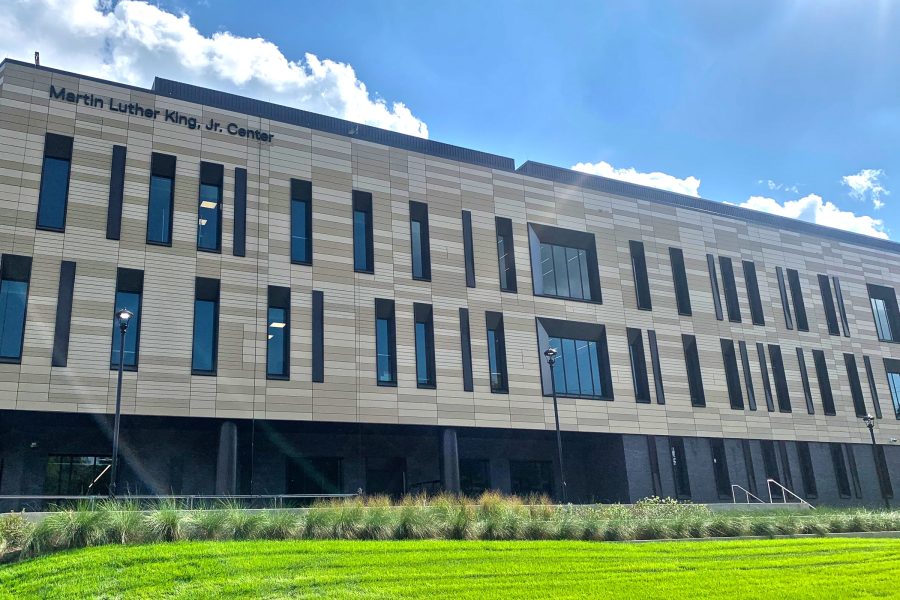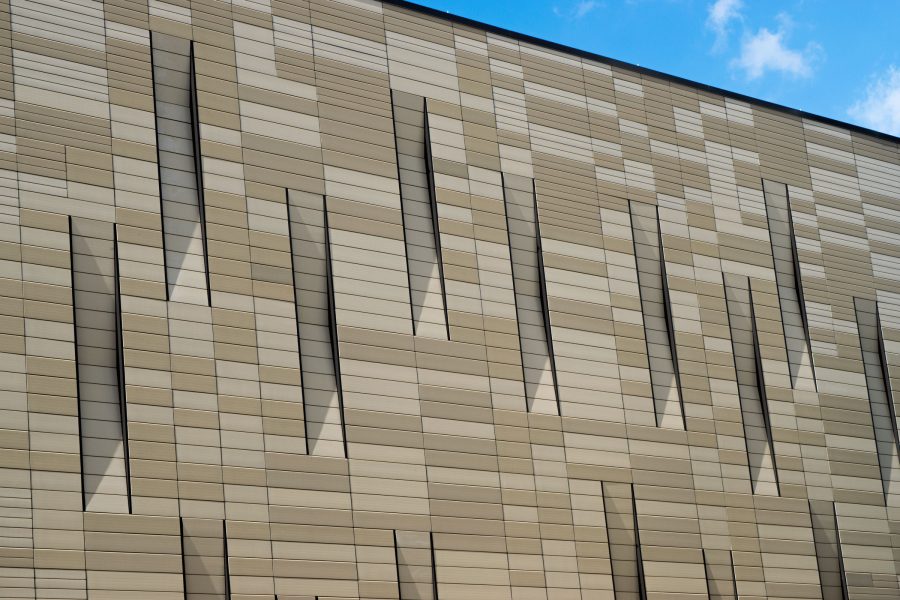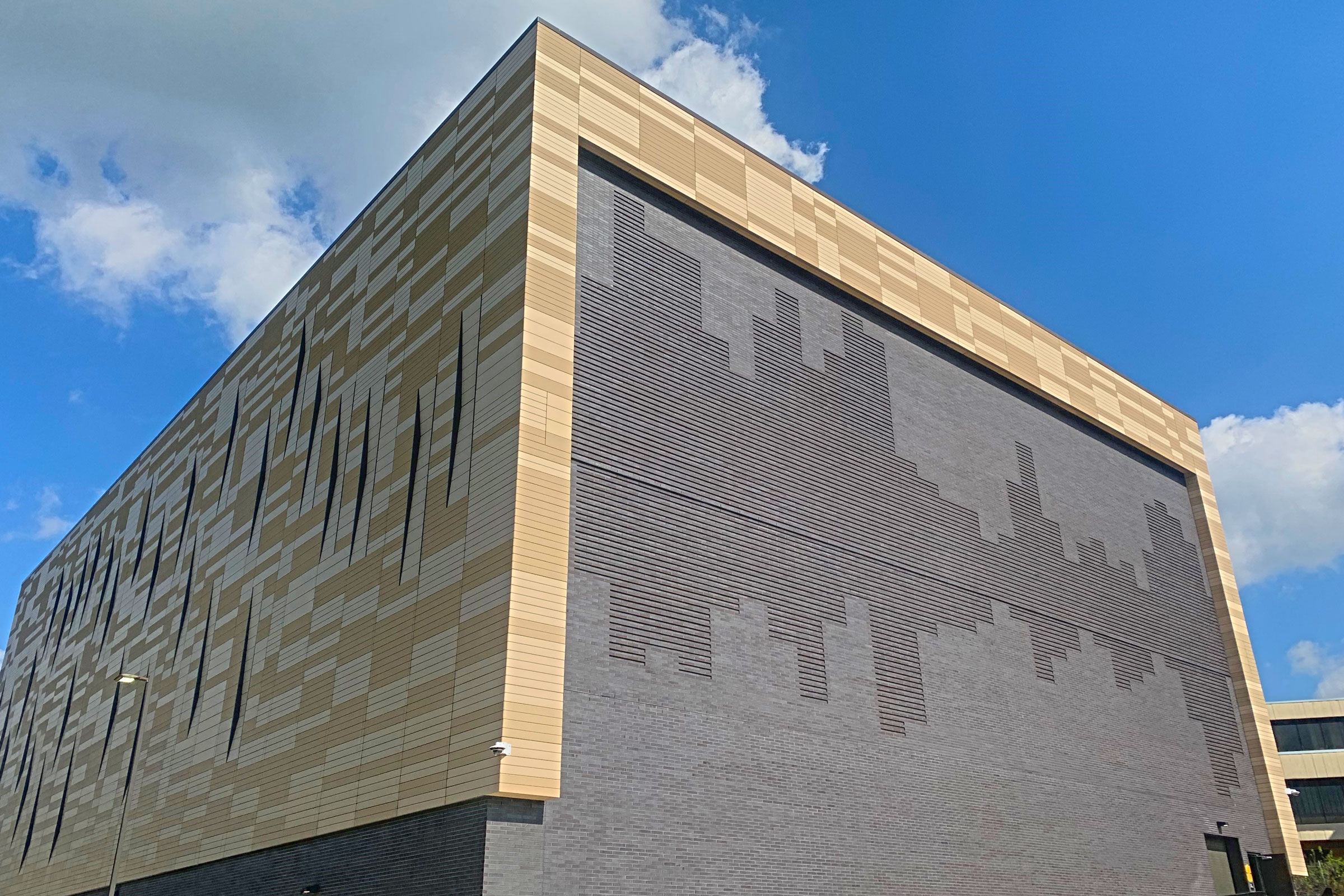Story at a glance:
- A groundbreaking terra-cotta facade is on display at Bowie State University, part of the University System of Maryland.
- Avenere Cladding’s NeaCera terra-cotta provides a low-maintenance rainscreen envelope while pushing boundaries in materials and architecture.
- The new Martin Luther King Jr. Center demonstrates how the versatile material fuses sustainability, durability, and aesthetics.
An eye-catching new building on the western edge of the Bowie State University campus, not far from Maryland’s state capital of Annapolis, beckons onlookers. The Martin Luther King Jr. Center is home to the school’s studies in communications and media, history, language, literature, and military science. The building offers ample space and inspiration for the majority of BSU students, since most will spend time here at some point in their coursework.
The center’s striking exterior facade, which shifts colors and dimensions depending on angles and daylight, features patterns created by terra-cotta panels of varying textures, layers, and depths. On the western edge of campus, it creates a visually intriguing gateway to the community, including commuters and travelers on the Northeast corridor railway who may glimpse the structure.
“We started to get into the idea of using terra-cotta because there was this sense of movement and the importance of learning through our past—and also that manifests and represents where we’re going in the future, including through communications,” says Carl Knutson, director of design at Perkins&Will, who designed the project.
Inside the facility is home to the school’s TV and radio station studios, recording chambers, screening rooms, and a 1,500-seat auditorium, among other features. Outside the terra-cotta rainscreen facade displays concepts in human interaction; the unique pattern of panels displays sound wave impressions from King’s 1964 Nobel Peace Prize speech.
Form and Function

Perkins&Will designed the Bowie State University Martin Luther King, Jr. Center. Photo courtesy of Avenere Cladding
The design team was drawn to terra-cotta in part for its low maintenance and durability. The rainscreen cladding protecting the thermal enclosure bypasses the need for wet joint systems that require sealants and associated upkeep. NeaCera® in particular is a lighter weight terra-cotta panel due to its single-solid leaf design. These features create efficiencies in initial costs and maintenance the university appreciated.
“In working with the university, durability was certainly an important part of the approach to the materials and design. They wanted to make sure it was a system that would last for the duration of the building’s life in a way that was low maintenance,” Knutson says. “The rainscreen allows the water to run through and wash out at the bottom. It allows the facade to breathe, providing functionality with a relatively simple system that also achieves the look that we wanted.”
Durability at a reasonable price combined with aesthetics proved to be a winning combination for the Bowie State project—and both the architects and manufacturers agree it’s a formula for broader success.
“It goes without saying that our German production with Westerwald clay produces some of the very best terra-cotta panels in the world. It’s one thing to ensure the system meets the aesthetic design and technical performance that top designers require to achieve their creative vision. It’s another thing to do it at a price point over the duration of the design and construction timeline that meets the project budget. That’s one of our cornerstones for success,” says John Stahl, vice president of sales at Avenere Cladding. “From a material standpoint it’s really attractive for the architects to come onboard with a material they can represent to their client as quality, durable, and aesthetically pleasing with flexibility in design options and with a good value proposition.”
Terra-cotta is also appreciated as a natural material—one that has been used for millennia all over the world in countless applications. It’s also environmentally friendly. “We talk about using thoughtful materials, and certainly this is a thoughtful project. With terra-cotta there’s a lack of environmental degradation; it has a lower carbon footprint. And there’s this incredible human history that lends itself to an intrinsic human connection to this material,” Knutson says.
Pushing the Envelope

Photo courtesy of Avenere Cladding
Terra-cotta’s versatility provides additional appeal and advantages over many other materials. Its uses have varied throughout history, and modern designers and manufacturers are finding new applications and ways to achieve innovative looks and functionality.
“There is a lot of flexibility to get creative with this material, more than other materials for exterior cladding, because of the vast ability to shape the material when extruding and an expanded range of finishes. In the big picture it gave our team the ability to take on a challenge and come up with solutions,” Stahl says. “We’re doing so many unique things and as we push the envelope with one client, these creative ideas become tried and proven solutions that exceed what anyone thought the material could do.”
For the Bowie State project the design and manufacturing teams worked together to create the visual contrast in the terra-cotta panels that achieves desired elements like the sound wave impressions. “Smooth panels, glazed panels, and grooved or “raked” panels were layered to convey a sense of animation,” Knutson says.

NeaCera panels are available in a variety of colors and shapes. Photo courtesy of Avenere Cladding
“There’s flexibility in the finishes that created a rhythm and a consistent palette we could work within to create variety in the components, and that gave us opportunities we wouldn’t have had with other materials,” Knutson says. “There’s a sense of sophistication in the engineering, but we could also be more artistic and represent movement and dialogue in the facade. We could be a little more poetic and tell these stories.”
While terra-cotta was key to this project’s success, the ability to push the bigger-picture boundaries ultimately comes down to more than the materials and design. The team effort at Bowie State illustrates the importance of collaboration in achieving breakthroughs.
“If you have that solid partnership and trust established, you can push the boundaries further, especially when you’re using unique materials like terra-cotta,” Stahl says. “Perkins&Will had some amazing design aesthetics on this project, and we worked together diligently on the details. When you have that type of collaboration, that’s what really makes for a real success.”

